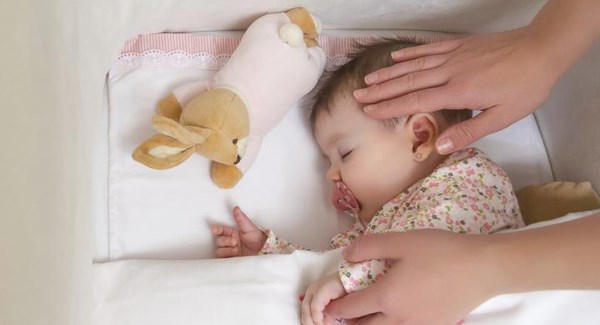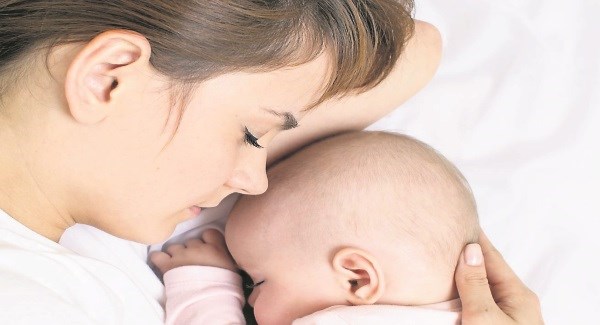
Lucy Wolfe, dubbed ‘The Baby Whisperer’, has a new book to help parents secure a full night’s sleep. It might just be the perfect gift for new mums this Mother’s Day, writes Áilín Quinlan.
Expecting your newborn to actually “sleep like a baby” means you could be in for bit of a shock, despite the picturesque lace-draped crib you invested in and all those rosy expectations about a calm and tranquil motherhood.
Because although a newborn’s need for sleep is high, its ability to actually go to sleep with ease and to sleep for long tracts of time is low, according to author and paediatric sleep consultant Lucy Wolfe.
Struggling with sleep deprivation can be exhausting and isolating, she says, and parents often feel like they’re entirely alone with the debilitating and frustrating effects of an infant’s fractured sleep patterns. It’s worse still in the midst of this Covid-19 isolation.
However, the big thing that most first-time parents should know, reassures Wolfe, is that most of the sleep challenges they can experience in the early few months of a baby’s life are actually typical infant sleep behaviours and not a problem that requires intervention.

“Although new parents may find this incredibly challenging when they have an otherwise healthy and typically developing child, your child’s sleep tendencies are not something that is a problem per se. They are actually representative of how young children sleep in the beginning, and sometimes, for much longer than the first few months too.”
The point, she explains, is not to look for ways to change your baby’s sleep practices, but to address your own expectations around its sleep patterns, so that you have coping strategies to deal with all those broken nights.
A mother-of-four with a business background, Wolfe began providing advice on sleep for newborns to six-year-olds about a decade ago. She has come up with a range of successful strategies around babies and sleep — one fan of her techniques is model Vogue Williams, who consulted Wolfe after her son, Theodore, experienced difficulties in sleeping.
Wolfe has since written two books on the topic, the first, The Baby Sleep Solution, and her latest, which hits the shelves this month, All About The Baby Sleep Solution; Your Questions Answered. Her interest in sleep was sparked when, as a young baby, her oldest son — now in his late teens — began to experience difficulty with sleep, prompting Wolfe to look for solutions
“I discovered that lots of people were struggling with babies’ sleep,” she recalls, adding that eventually she decided to research the subject in depth. After training in the area of child sleep in the UK and the USA, she earned a diploma in parent mentoring and relationship studies in UCC, opening her consultancy, Sleep Matters, in 2010, providing both one-on-one and remote consultations on sleep. “Parents can have expectations that don’t match the reality of infant sleep,” she warns.
“I don’t feel that the challenges experienced by many parents are problems.
It can be very difficult when your baby is born if he or she struggles to sleep or is difficult to settle, but a lot of these challenges are typical infant sleep, so it’s about explaining to parents that a lot of it is quite normal.
Among the most common issues that parent presents with, she reports, is that their baby will only sleep in the mother or father’s arms: “This is because the baby has come from the womb and want to be held,” she says, adding that contrary to what many parents believes, this is not a bad sign: “ This is often viewed as a problem by parents but in fact, the baby is designed to be close to you and to keep you close to them.
“I also feel that it can be nature’s way of trying to get parents to slow down.”
So it’s not about a baby’s ‘bad’ sleep habits but about the parents becoming attuned to its needs. Take for example, the newborn’s habit of waking during the night. Although this is exhausting for the parents, it’s entirely normal because it ensures the baby receives the necessary feeds and interaction.
View this post on Instagram
“For new mums and dads, this is about understanding that this time will be difficult but it will pass,” Wolfe says, adding that part of her work is “about normalising the very normal sleep behaviour in newborns to new parents.”
Understand, she urges, that a newborn’s sleep system is immature for a while after it’s born and don’t try to force them into rigid feeding or sleep routines: “I discourage strategies such as pacing feeds to take place every three hours, for example,” she says, adding that she encourages parents to “go with” a baby’s feeding routine.
What she does encourage them to practice is what she calls a “cue-based dynamic” which means learning to read your baby’s body language and becoming attuned to its needs: “It’s not about being prescriptive,” she says, adding that she encourages a “responsive” dynamic: “I encourage parents to learn the baby’s language of sleep. An early sleep cue might be presented, for example by a brief eye-rub or a brief yawn or a moment of quiet that indicates sleep readiness.
“If you’re proactive around that and put the baby down to sleep, your baby will be in synch with its body clock and have more of a chance of going to sleep with ease and staying asleep for longer.”
If you don’t recognise those early cues, she observes, the baby can become over-tired and those symptoms become more noticeable. In fact, says Wolfe, many parents do wait for the more intensive cues to appear – however, far from indicating a readiness to sleep, these can represent over-tiredness, which in turns makes it more challenging for the child to go to sleep and to stay asleep.
If you learn to read the language of sleep so that you can act before the baby become overtired, that can be part of the key to establishing positive sleep practice.
She also advises to ‘go along with’ a baby who seems to want lots of holding. In terms of putting good daily structures in place, she advises getting into the habit of exposing the baby to bright or natural light at a certain time each morning – no later than 7.30am when you feed.
“It’s putting some landmarks in place in the day,” says Wolfe who is also an advocate of instigating regular pre-sleep rituals or bedtime routines, from about the age of six weeks. Such routines would involve taking baby into the bedroom at night, dimming the light, changing them into their sleep clothes and telling a story, which all together provide a regular context for sleep.
In tandem with this Wolfe operates a Percentage of Wakefulness approach, used with babies from about six to 12 weeks, which helps increase a baby’s sleep ability so that he or she sleeps longer at night. “This approach helps baby develop a higher sleep ability,” she explains.

This means that instead of holding the baby in your arms or feeding it until it’s asleep, you ensure the infant is still slightly awake when you lay it in the cot: “This way they have to put in a little effort into getting to sleep. They’re doing some of the work for themselves” the baby is cognisant that it has been put down, even in a small capacity. This means that when babies start to cycle through sleep, she says, they’re more likely to sleep through their natural sleep phases and only wake when hungry.
This may, she says, prevent them from waking unnecessarily, as the brain learns early on to get through the phases of sleep – and all of this learning can be achieved at bedtime.
“If the baby just falls asleep in your arms he or she is as aware of any sleep routine, whereas if they are a little bit aware they are being put into the cot, that’s a step forward for them in learning how to put themselves to sleep, even to a small extent.”
Then there’s her ‘Nap Gap Dynamic’ which can be used to support babies who show a resistance to sleep. This, explains Wolfe is caused by a range of factors such as timing or over-tiredness. She uses the Nap Gap Dynamic to help regulate the body’s expectations around sleep: Essentially, the Nap Gap Dynamic, which she explains, is firmly underpinned by the science of sleep, is about the relationship between the timing of the final nap and bedtime.
View this post on Instagram
“Between four and eight months, most children do well if they’re not awake for more than two hours between the last nap and bedtime,” she explains. “So if baby has a bedtime of 7pm and naps as close to 5pm as possible, you aim to have him or her in bed asleep for 7pm. As baby naps up to 5pm you are reducing the risk of over-tiredness, which is what causes a lot of problems around sleep resistance.”
The nap gap dynamic changes as children get older, she explains — for example, between eight and 18 months the gap can stretch to three to four hours, so a child with a bedtime of 7pm would have their last nap around 3pm or 3.30pm.
Last but not least, she recommends her Stay and Support Approach, where parents do not hold or rock a baby to sleep, but remain in the room and are physically supportive to the baby — they may stroke or rub the baby, give lots of verbal reassurance and make eye contact or use distraction techniques such as blowing in the baby’s face: “What the parent is doing is showing baby that he or she can sleep safely with the parent in the room,” she says, adding that helping the baby be more independent of the parent where sleep is concerned helps build better sleep practise.
All About The Baby Sleep Solution; Your Questions Answered by Lucy Wolfe. Gill Books €16.99.

